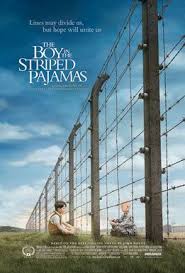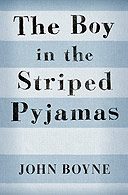
J. BOYLE :THE BOY WITH THE STRIPED PYJAMAS. Introduction.
1. Look at the cover of the book. List the items you can see on it. Use specific vocabulary.
2. Just by looking at the book cover, what sort of story can you imagine? Write down a few lines about what you may expect.
3. «Lines may divide us, but hope will unite us.»
«A story of innocence in a world of ignorance.»
Comment these quotations in a few lines. What do they mean? Can you draw a connection with the picture on the book cover?
Chapter 1. Bruno makes a discovery
Summary: write 4-6 lines to sum up chapter one.
Vocabulary:
p.1 : a maid: une servante, une domestique
to bow: faire une courbette, révérance
wooden crates: des cageots
to muster: marmonner
to bundle: faire son baluchon, paqueter
p.2: whether .... or: si .... ou .... si
though: cependant
the butler: le maître d' (hôtel)
=~ chef des domestiques
p.3: the rims: les bords
to bother: tracasser, ennuyer
a Hopeless Case: un cas désespéré
p.4: to nod: hocher de la tête, approuver
mucky: sale, boueux
hands of a clock: les aiguilles (montre,
pendule)
to steer clear of : se tenir à l'écart de
a smock: une blouse (de travail)
p.6: slanted : en biais, inclinées
the frame: le cadre
p.7: the rules: les règles
to splutter: bredouiller
to munch: mâcher
p.8: that would be telling:
ça serait trop en dire
to snap at: rembarrer, rétorquer
p.9: the bannister: la rampe
a whooshing sound: dans un souffle ,
qui fait zoum
Questions on the text.
1.Write down the name of the characters who appear in Ch.1
2.What is special with the way they are spellt?
3.Write down two expressions that Bruno uses which are specific to him.
4.What does the packing mean?
5.What is going to happen to Bruno?
6.What do the capital letters at the beginning of Mother, Father, Fury mean?
7.Who might Gretel be?
8.Who tells the story?
9.How do you know? Give a few examples which illustrates your saying.
10.What social class does Bruno belong to ? Find a few examples which illustrate your point.
11.Where does the story take place?
12.Who are Karl, Daniel, and Martin?
13. What moment of the year does the story take place?
14. What does he like best in the house?
Chapter 2+3: The New House The Hopeless Case
Summary: write 6-7 lines to sum up chapter two and three
Vocabulary:
p.12 : nooks and crannie: des recoins
to stroll:se promener, se balader
overspilling: qui débordent
to feel dizzy: avoir le vertige
p.13: frothy: mousseux
p.14: to chalk it up to experience: le mettre sur le compte de l'expérience
p.15: foreseeable: prévisible, proche
p.16: cubby holes: cagibi, débarras
a chest of drawers: une commode
full to the brim: plein à ras bord
p.17: a creak: un craquement
p.22: to mistake: se tromper
p.23: to spin around: tourner autour
p.24: to acknowledge: reconnaître
a bedspread: un couvre-lit
p.25: with a thud: avec un bruit sourd
p.26: hollow: creux
p.27: a driveway: une allée
ripe for: mûr pour
p.28: to swallow: avaler
p.29: pigtails: des couettes, des nattes
Answer the questions below.
1.What adjectives are used to decribe the new house?
2.What is Bruno's worry?
3.Complete the chart below.
House in Berlin
New House
4.List the name of vegetables Bruno mentions and write down their translation in French.
5.What are the other characters like?
6.Draw a portrait of the Young Officer.
7.What did Bruno see from the window in the ceiling? Do we know?
8.What do we know about Gretel? Draw her portrait.
9.What does « OutWith » stand for?
10. Creative writing: write down what you imagine Bruno has seen from his window. Use specific vocabulary. Write a minimum of 12 lines. Use your imagination.
Chapter 4:What they saw through the window:
Summary: Write 4-6 lines to sum up chapter four.
Vocabulary:
p.31 : to tend: s'occuper de
a misty moor: une lande brumeuse
p.33: to spread out: s'étendre
p.34: suitable: qui convient
to peer around: regarder autour
p.35: barb wires bales: les rouleaux de barbelés.
stacks: les tas
p.36: chain gang :travail en équipe, enchainés, pour du travail pénible
wheelbarrows: brouettes
to be spotted: être aperçus
crutches: les béquilles
p.37: huddled together : serrés les uns contre les autres
to lunge: bouger par accoup
filthy: sale
Answer the questions below.
1. « They were everyone » . What does it mean?
2. What else do we learn about Gretel.
3. What do Bruno and Gretel's questions about the countryside show ?
4. Describe the relationship between the brother and sister.
5. How far is the camp?
6. How many people could they see?
7.What had all these people in common? What connection can you draw with the title?
8. Written activity: what do you think is going to happen? Write down 10-15 lines telling what is going to happen in the next chapters.
Chapter 5:Out of Bonds at All Times
Summary: Write 4-6 lines to sum up chapter five.
Vocabulary:
p.31 : to load: charger
a truck: un camion
p.40: to frown: froncer les sourcils
to shrug: hausser les épaules
p.42: in awe: qui a peur de ed: tend: s'occuper de
p.43: efficiency: efficacité
laughter: éclat de rire
in a row: en rangs
p.44: a handful: une poignée (de)
p.45: gloomy: sombre
mahogany: acajou (bois)
to give a hug: tenir dans ses bras
slobbering : baveux
p.46: overawed: intimidé
to clamber: grimper
p.48: tears welling up: les larmes lui monter
to disappoint: décevoir
p.49: to argue: discuter, répliquer
a gaze:un regard
p.52: to blink: cligner des yeux.
Answer the questions below.
1. How long has passed since they arrived in their new place?
2. What does the flashback of Bruno's arrival in the new place tell us?
3. How did they travel?
4. What year are we?
5. On p.44, what are « the two words that Bruno had been taught to say »?
6. List adjectives that Bruno uses to describe the new place. What do they tell the reader?
Listening comprehension. Watch the extract and answer the questions below.



